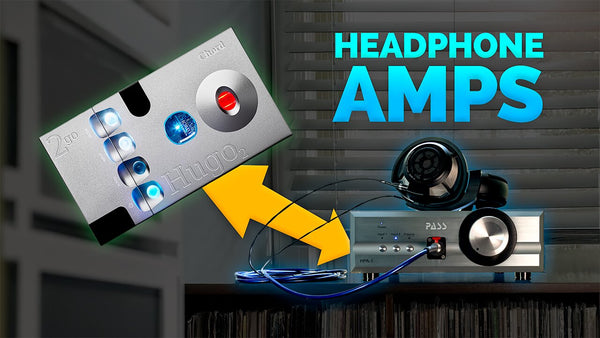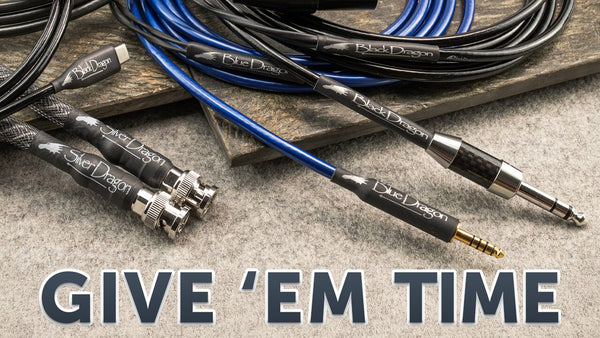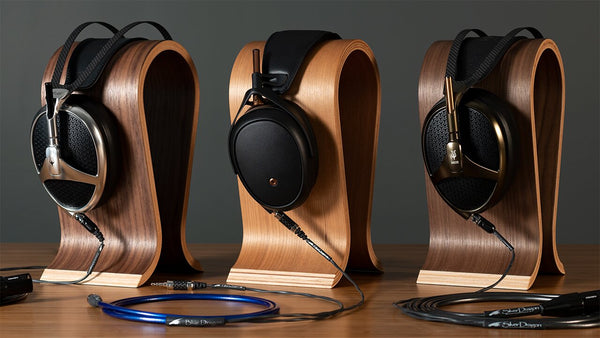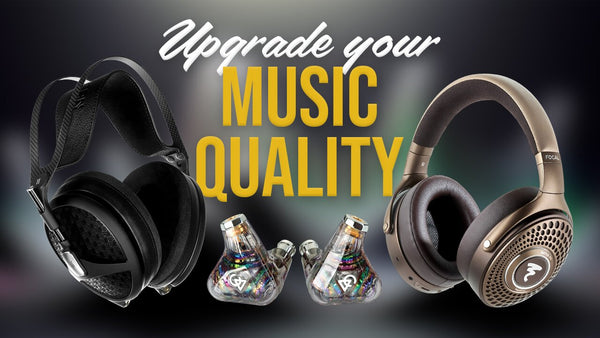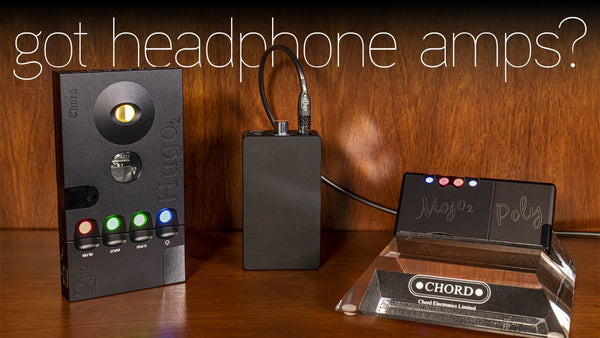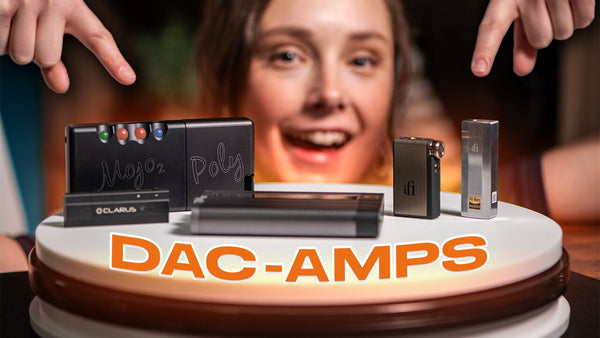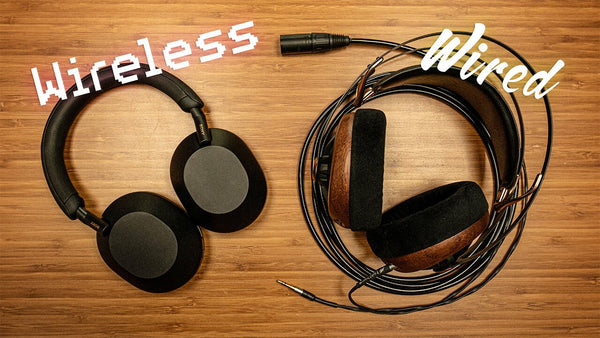The Dragon Cable Experience: Why Audio Cables Matter

Dragon Audio Cables: What It Takes To Make Award-Winning Cables
Are all audio cables created equal? We would argue that they are not. This guide covers everything you'll need to know about audio cables and to determine if high-end audio cables are ultimately worth it. From materials to sound signatures, we'll also give you insight into what goes into designing our award-winning Dragon Audio Cables and see firsthand what they can do for you. Here at Moon Audio, we're only concerned with making your music sound its very best, and audio cables (headphones, speakers, digital, etc.) that use premium materials are one of the easiest ways to achieve that.


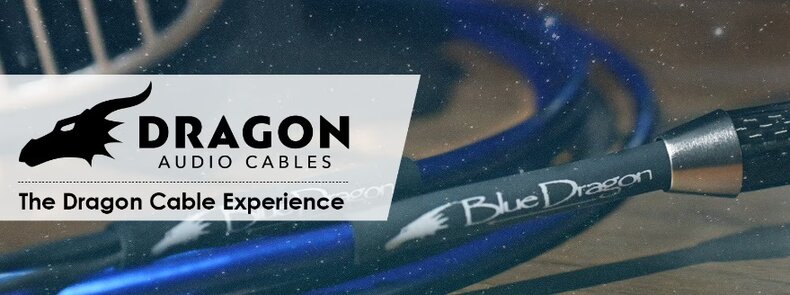

About Audio Cables

You’ve heard the saying that a chain is only as strong as its weakest link, right? Well, the same applies to your brand-new audiophile-grade headphones or other audio components. The weakest link in this case is your stock cable or the stock interconnects the manufacturer threw in the box just to connect your audio components. Why is it the weakest link? There are many reasons but foremost is that your stock cable isn’t manufactured in the same way your high-end product is that it accompanies. Your audiophile-grade gear has been tested, manufactured, milled to precision, and finely tuned, all while using the best materials and consideration. Unfortunately, the same cannot be said for your stock cables. They are often mass-produced, spec'd specifically for the product, and not quality controlled in the slightest. I might be a little harsh here, but the fact remains that the same care and consideration for your product is not mirrored in the accessories, especially the stock cable.
Most of the time, companies skimp on the audio cables included with their headphones or audio components because they're an afterthought or simply a means to an end. They put their R&D into the driver for the headphones and rightly so, as it makes the most difference in the sound quality of the headphones. However, they use poor materials in the cable that connects the headphones to your music source which creates a bottleneck in the sound or a curtain or veil in front of your music. Audio cables are more reliable than wireless connections, capable of transmitting the highest audio resolutions, and they are the easiest way of setting up your audio system. They are critical, and yet they are often an afterthought. Why do companies skimp on cheap materials and connectors? Because customers are buying the product, not the cable. We’ll learn more about this later in the article. The other thing to consider when questioning if cables make a difference in audio quality is that everyone hears differently.
We all have a friend who hates the music we love. Rap versus country, rock versus metal, polka versus a cappella indie experimental death folk – there’s always a yin to the yang. But why the difference? Without getting too philosophical and talking about how your musical preferences come down to your cultural upbringing and life experiences, we can at least discuss one thing that truly sets us apart. The “experience” of listening to music in actuality has much to do with how we physically “hear” sounds. Particularly, when the inner ear receives sound, it triggers a reaction from the different brain cells that are responsible for transmitting the information to your brain. That triggering forms different patterns that, in turn, touch different parts of the brain, explaining why we associate certain sounds with certain memories and feelings. However, that might not be the case with everyone, as we are all wired differently too. The science is still new, but everyone agrees that we experience and perceive sound differently on a physiological level. Many things can be attributed to this, especially age, gender, and other various personal demographics.


I’m sure most of us remember the Yanny/Laurel phenomena that hit the internet a few years ago, but this just further drives the point home. It’s a single sound clip, but two people can be hearing completely different things based on which frequency response they are focusing on (or hear since higher frequencies are often the first to go with hearing loss). The auditory version of the “White Dress” viral image, Yanny/Laurel helps us to easily perceive how we can hear completely different things from one another.
The same can be said for our senses. No one smells, sees, tastes, or feels the same way either (e.g. the White Dress viral image). Yet, there are common properties that make things appealing to the masses, like pizza, roses, and puppies. If you don’t like puppies then you’re not human. It’s simple science (joking). The same goes for sound. It’s not something that is easily explained outside of physiological differences, but it exists.
How do you quantify or qualify something that cannot be measured? No one argues that music makes us feel good. It can affect our mood for better or worse and heightens our senses. The argument that “it exists” is not entirely convincing or satisfactory. The fact remains, however, from the very physiological responses our body makes while listening to music. The reaction is itself proof that something is happening. The excitement and adrenaline rush when you hear the finale of your favorite symphony, the longing and emotion that is fueled from a sad song, or the thrill of yelling your favorite song with your friends as you drive down the road; music is the catalyst for these emotions.
The only thing we really know is that music affects our brain in such a way as to cause these reactions and emotions. We can only measure them by observing a response when “interacting or listening to music” and that they stimulate our brain in such a way as to create a physiological reaction. How music makes you feel can be as varied a response as the number of music genres in the world. It can also depend on several variables, the least of these being your current mood. Music not only speaks to people differently but also at different times. I can’t tell you the number of times I get goosebumps listening to a song, want to listen to it again, and it’s great – but it just doesn’t have the same impact as it did the first time listening to it. Months later I'll listen to it with some rested ears and there it is again – the goosebumps. It's difficult to measure emotions apart from observing neuron activity and other physiological reactions, unfortunately, the fact that we all hear and experience music differently only exacerbates finding a solution to the question if audio cables make a difference. If there is such a strong subjective component to this debacle, is there anything objective we can study?

So, if everyone hears differently, how do you establish a control when trying to compare audio quality A versus audio quality B? In the case of audio cables, one thing that we can qualitatively measure regarding audio quality are the materials that the cables are made from. Materials matter, and just like cables, and not all materials are made with the same quality, care, and consideration. You get what you pay for (although there are always exceptions to the rule).
Audio cables are composed of various materials, but the ones we’ll be concerned with primarily are copper and silver. The copper and silver strands are the core of the cable, transmitting the audio signal from one end to the other. Why copper and silver? Copper is an incredibly conductive material, used in both audio transmission and heat dissipation/thermal applications. The reason that copper is the most widely used material for speaker and headphone cables is due to its low cost and low resistance. Audio-grade copper will be much different than commercial-grade, as Cardas points out, “What we had discovered in commercial copper was a severe shredding of the crystalline structure. Basically, charges and heat flow are scattered by impurities, imperfections, and inhomogeneous metal structure.”

In other words, quality control. Most copper is formed from crystals; each of these crystals is contained in many small regions called grains and in between the grains are boundaries. * The electricity must pass through these boundaries, but depending on how the copper is manufactured, these grains and boundaries can worsen and become more numerous. Copper tends to sound warmer and gives more “body” to music, but it is slower and less harmonically rich than silver. Silver sounds lively while offering more clarity and harmonic richness to your music. The downside to silver is that depending on the genre, it can create a cold characteristic to the audio, making it sound thinner and harsher in higher frequencies in worst-case scenarios.
Audio cables should be made from pure materials; impure materials can introduce “nonlinearities” (the oxidized copper can behave as a semiconductor) that can develop as increased distortion at low signal levels. Distortion ultimately takes away from the clarity of the signal, depending on the level of the signal. The purer the material, the less artifacts will be introduced into the audio signal. Now some people might argue that cable impurities will not cause any audible difference to the human ear; you’ll hear stories online of people using an actual coat hanger as an audio cable without any noticeable difference. I hate to say it, but if you can’t hear the difference between a coat hanger and a high-end cable, then your entire sound system isn’t serving your music justice.
The general rule of thumb is the better quality of the cable = the fewer impurities in the materials. The same can be said about silver. Silver is more conductive and more expensive to produce than copper. The conductive properties of both materials are easy to measure. However, what does conductivity have to do with audio signals? The better the conductive properties of a metal equate to the loss of current or signal. So, the more conductive the metal is, the more suitable it is for audio applications. Of course, there are so many other factors that affect the sound signatures of both copper and silver including the age of the material, Insulation, Oxidization, Conductor geometry, Purity, Direction, Treatment, Temperature, Etc… We’ll get into a few of these below.
The process of oxidation diminishes conductivity, which is why “purer” materials are not oxidized. Copper oxidizes rapidly, which is why they are often coated to prevent or slow down the process to maintain its conductivity over time. Gold is less conductive than copper, by an estimated 40%. However, cables with end terminals that are coated in gold will retain their conductivity over time since gold does not oxidize. Rhodium-plated ends are only half as conductive as gold and even a third of silver’s conductivity but are immune to corrosion and oxidation. Nickel, bronze, brass, and other materials also have varying conductivity compared to copper but can oxidize at different rates, resulting in varying performance to that of copper at varying oxidation levels. For instance, a gold end terminal might be less conductive, but it will be superior to a highly oxidized copper terminal. Purity is key. Oxidization affects sound. Also, note that oxidization is not to be confused with the process of manufacturing the strands themselves. We'll discuss the differences between UFC and OCC processes later.


Conductors – Are More Conductors Better?
A conductor is just the material used that transport the electrical current or audio from the source to its load. For the sake of cables, we’ll be discussing silver and copper since they are the most used and common conductors within audio cables. To make it simple, more is not necessarily better. It really depends on the application. The most common wire used in construction uses 3 conductors: hot, neutral, and ground. However, cables today can be manufactured to range from 1 to hundreds of conductors. We use four conductors in our Silver and Black Dragon Headphone Cables and eight in our Bronze Dragon IEM and portable headphone cables for reference. As we will see later, it’s not so much the quantity as it is the quality of the conductors that really make the most difference in the fidelity of your music.
Sound Signatures

Every headphone, cable, and music player has their own intrinsic sound qualities. Some emphasize the higher treble ranges while others strengthen the bass frequencies. This overall sound profile is called a sound signature and understanding the basic categories will help you pair your cables and devices to fine-tune your listening experience. Sound Signatures describe how high and low sounds are emphasized (or not emphasized). The range from highs to lows includes Bright, Analytical, Neutral, Warm, and Dark. V-shaped has lower mid frequencies. The frequency spectrum helps to determine the sound signature. Different levels of sound in Hertz, or Hz, are measured on a spectrum and the properties of the materials in the cable and/or headphones can influence the frequency response of your music. Let’s look at some graphs to better understand how this is visualized.






Every piece of gear in your sound system has a sound signature. Your DAC, the amp, your pair of speakers, or headphones; they all have their own material properties that can affect the coloration or resonance of your music, altering the way it sounds from the original. Although it’s not necessarily a bad thing, the trick is choosing gear that is going to best match the type of music you listen to.
The variations are endless: Beryllium drivers are forward sounding, planar magnetic drivers tend to sound more resolute than neodymium cone drivers, often resulting in a dip in lower frequencies by comparison, open back headphones have a larger soundstage than closed back, tube is going to sound warmer than solid state, and on and on. Even to the experienced ear, pairing your gear by sound signature can be tricky unless you know what to listen for. Usually, the output is the most important part in influencing the sound signature of your music, being speakers and headphones. What most people don’t realize is that the materials in cables can bring out the best or the worst of your sound output, depending on how they are matched.
At Moon Audio, we use the best raw materials in our cables to unveil your music. We believe that the materials matter. Your cable should have the same care and craftsmanship that manufacturers put into their audio cables. Why is the cable always an afterthought, when it’s just as important as the rest of your system? It is ultimately the connection to your music. The fact remains that cabling is often considered the last priority to that of the main product and a means to cut down the overall production costs. It’s as simple as that. Generally, stock cables are manufactured with subpar materials, metals with impurities, poor geometries, and an overabundance of layers to make them look and feel like a fire hose. Inconsistency and lack of quality control in stock cables can lead to poor sound quality and a veiled sound vs what the musician intended for you to hear and feel from the music. Dragon audio cables are handcrafted daily by our engineers in Cary, NC to the highest standards and made to order according to your specific connection. At Moon Audio, we create a custom cable for you using the highest quality UP-OCC silver or copper conductors that can be manufactured. We have one of the largest collections of connection options available and we can create hundreds of combinations depending on your specific gear and needs.

Materials matter. Remember that? Copper and Silver conductors can craft the signature and affect the overall tone of your music. If your headphones are too forward sounding for the kind of music you like to listen to, don’t worry – pairing them with a Black Dragon headphone cable will bring out more warmth and create a music presentation which should counter-balance the troublesome higher frequencies of your headphones. On the other side, if your headphones are very warm sounding, then pairing them with a Silver Dragon headphone cable will bring out more details and tighten up the lower frequency ranges. There is always a perfect cable pairing depending on what you want out of your gear or music.
Dragon Audio Cables

We customize audio cables for virtually every pair of headphones on the market and tons of other types of audio gear. From connectors to sound signatures, the possibilities are endless. Each line of our Dragon Cables has been engineered to bring out the best in headphones with specific characteristics. Read more about our different cables below.


The headphone connectors are soldered directly to the conductors of the cable. The splicing method used by other cable companies using a stock cable's connectors is a poor method. We have developed many of the hard to find connection options utilizing plastic injection molded connectors. Great expense has been taken to bring as many hard to find connection systems for the most popular headphones. If you can't find the connection system you desire please contact us. The wire is soldered to the connector with Cardas silver solder. The overall quality of the materials used for the Black Dragon cables translates to durability and making sure your cable can perform at peak performance for longer than other, less efficient stock cables.
The Black Dragon is warm and smooth with a musical presentation. Copper strands enhance the body, shape, and immediacy of the music. The detail and expansiveness of the Black Dragon make it a flexible fit where a broad range of musical genres are played. It can also improve bass frequencies on bass-light headphones. The smooth, musical quality makes it a perfect fit for headphones that tend to sound a bit edgy or bright. Despite its warmth, the Black Dragon does not have a laid back, lush sound. It is much closer to a neutral sound signature, making it a very natural sounding cable.

The Bronze Dragon helps create a warmer presentation with a bigger and fuller body adding bottom-end strength and muscle. Our new Dragon cable is musical without becoming lush or bloated. In cases where you own a bright or thin-sounding IEM or portable headphone, the Bronze Dragon will add body to the sound. It will provide a fuller, bigger presentation of the music. The bass will have more weight to it without being bloated and lush sounding. The Bronze Dragon has a warm and musical sound signature.
Bronze Dragon cables have 8 x 99.99998% UP-OCC Stranded Copper conductors per cable, surpassing our Black Dragon IEM headphone cable V1. Used in just the right ways and proportions, copper helps add warmth to expand and strengthen sound from bass guitars, cellos, and deep vocalists like Barry White.
There are two variations of the Bronze Dragon Audio Cable, one for IEMs and the other for portable headphones. Designed for 2-pin male IEMs (such as JH Audio, Noble, and Westone), our Bronze Dragon IEM Cable features a 45-degree angle on the lead. This effectively wraps the cable up and around your ear for more comfort and better sound.
Designed for portable headphones, the Bronze Dragon portable cable features a single-entry design for use with Sony WH1000-XM5, Sennheiser Momentum, and similar headphones from manufacturers like Bose, Ultrasone, and AKG. The Bronze Dragon Portable cable is designed for listening on the go with headphones like the Sony WH-1000MX3, Sennheiser Momentum, and similar single-entry connection headphones. The Bronze Dragon helps create a warmer presentation with a bigger and fuller body, adding bottom-end strength and muscle. Our new Dragon cable is musical without becoming lush or bloated and features a flexible cable that's perfect for on-the-go applications.
With a warm presentation, Bronze Dragon strengthens the bottom end without becoming bloated. Bass guitar and cello are full and immersive, creating a musical that's not too lush. The warmth and fullness of the Bronze Dragon create the muscle needed to round out a flat signature.

The Blue Dragon headphone cable is a neutral and natural sounding cable which is great for vocal performances. It is a good fit if you want to improve clarity and dynamics in your headphones and do not want to add coloration. Furthermore, if you do not want to tip the headphone forward or back, then the Blue Dragon is a wonderful choice. The Blue Dragon is our value full size headphone cable. Using copper strands, it combines the neutrality of the Black Dragon with the clarity of the Silver Dragon at a lower price point. Its calm and neutral sound make it a great place to start with premium cables.
The Blue Dragon Headphone Cable has been designed to match the Silver Dragon headphone cable but with a high purity copper conductor using the Ohno Continuous Casting Process. With the neutrality of the Black Dragon and the clarity of the Silver Dragon, the copper-based Blue Dragon will "clean" the sound of your headphones without warming or brightening it. You can think of the Blue Dragon like a wipe for your eyeglass lenses: You're removing obstructions to the best view but not altering your prescription.

In much the same way as the headphone cables, USB cables can adjust the sound signature of your digital music through USB audio transmission. Standard USB cables are not up to the task of large bit rate information. The materials of the Dragon USB audio cables are designed to handle large-capacity data transfers with ease, ensuring that every bit of your high-resolution audio is delivered to your high-fidelity system.
Dragon USB audio cables come in Silver and Black variants. They can be customized with many different connection types according to your personalized needs, and provide enhanced detail and resolution for the best performance for all your audio data transfer needs.
Conclusion: Do Audio Cables Matter?


In short, yes. Materials matter. Better materials mean better performance and longer life. The higher quality materials used in premium audio and digital cables are irrefutably better quality than the materials used in OEM cables. This can translate to a number of improvements including better shielding, lower noise floor, natural dB boost, and overall improvement in clarity, soundstage, and definition of audio.
Moreover, that’s the crux of our argument here: do better cables result in better sound? Answer: Try it. Test it out. See what works for you. Everyone hears differently, and at the end of the day, the goal should always be to strive for better audio quality for the music you love. If you have any questions about audio cables, please Contact Us and we’ll be happy to answer any questions you may have! Happy listening!
Related Blogs & Videos
Best-Selling Dragon Cables of 2023: YOUR Favorites
Dragon MMCX IEM Cables: Everything You Need to Know
Why Headphone Measurements DON'T MATTER
FAQ
https://www.moon-audio.com/dragon-audio-cables.htmlDo high-end cables make a difference?
High-end audio cables use higher-quality materials. Materials matter. Better materials mean better performance and longer life. The materials used in premium headphones and audio cables are irrefutably better quality than the materials used in OEM cables. This can translate to a number of improvements including better shielding, lower noise floor, natural dB boost, and overall improvement in clarity, soundstage, and definition of audio.
Do cables affect sound quality?
They can, depending on the types of materials they use. Factors like shielding can legitimately affect the amount of interference and noise that the audio signal will be subjected to. Long cable runs can act as antennas and shielding is quite important. Materials like copper and silver conductors and the quality of those conductors will affect the sound signature of the audio. Oxygen-free conductors also sound different from cables with oxygen-laden conductors. There are many factors that can affect the overall audio quality of your cable. We use what is called UP-OCC. This stands for Ultra Pure Ohno Continuous casting. This is a process developed by Dr. Ohno of Japan. Conventional methods of extruding copper result in multiple and fractionated crystalline structures. Oxygen-Free Copper (OFC) has a distinctive effect on your audio quality that some might find lacking. The OCC process uses a heated mold for extruding, whereas other processes involve a cooled mold. The cooling process in OCC takes place separately, resulting in larger crystal sizes and increased purity. So, from a materials perspective, the OCC process is far superior to OFC. Check out our Handcrafting Dragon Audio Cables process for more info.
Are good cables important?
Cables are the connection to your music, so having good audio cables is especially important to improve sound quality. Poor quality cables and poor connections can lead to noise, static, audio cutout, and much more, negatively affecting the quality of your music.
Are balanced cables better than unbalanced cables?
Balanced cables are not necessarily better than unbalanced or single-ended. Again, it depends on the gear circuit design of the products in your sound system and how they are configured. To learn more about balanced versus single-ended, check out our guide HERE.
Why are there different Dragon Audio Cable variants?
Our Dragon Audio Cables feature different metal configurations, each having different audio sound signatures when paired with your speakers or headphones. The Silver Dragon lends more detail and soundstage, making it a great pairing for warmer headphones. Black Dragon cables add more warmth and body to make them a great pairing for forward-sounding and analytical headphones. Blue Dragon cables are a great value, improving the clarity, staging, and detail on any headphones. Lastly, the Bronze Dragon improves thin-sounding headphones and IEMs, warming and rounding out a flat signature. There are also USB, digital, interconnects, speakers, and power cables that are also handcrafted to your specifications. Each of these cable types have specific audio signature properties that can help to lift the veil of your music on any device and connection type.
Is copper or silver better when choosing an audio cable?
Each has its own sonic properties that can positively or adversely affect your music, depending on the genre, headphones, or amplifier you are listening to. Silver is more conductive than copper but can also thin out your music if paired with a forward-sounding headphone. Likewise, copper can fill out the low end and create a warmer and more musical presentation, which is great for non-bass-heavy genres. One is not necessarily better than the other, but there is a better option (of the two) depending on your system and the type of music you like to listen to.
What is a sound signature?
Every piece of gear in your sound system has a sound signature. Your DAC, the amp, your pair of speakers, or headphones; they all have their own material properties that can affect the coloration or resonance of your music, altering the way it sounds from the original. The sound signature of a piece of equipment can be forward, warm, musical, or bright, just to name a few. To learn more about sound signatures, check out our guide HERE.
How do I compare audio cables?
The best way to compare audio cables is to test them. A-B testing is a way of simply comparing one cable to another. Using the same song and audio gear, it will become easy to tell how the cables affect the overall sound quality and soundstage of your music.
How do I know if one audio cable is better than another?
It really depends on your listening preference. Through an A-B test, if one cable brings out more sonic properties that are appealing to you, then that would be considered the best cable for you. It's important to understand that everyone hears differently, and what someone might consider better sounding might not be the case for you. That’s okay. The priority is figuring out what sounds best to you so that you can enjoy your music to its full potential. There is no right or wrong to this.
Are certain cables better for specific genres of music?
Silver or bronze copper conductors can bring out specific qualities in your music that can either be complementary or adverse. It depends on what you like to listen to and how you like to listen. For instance, regarding classical music, some people like to listen with a Black Dragon cable, which lends a warmer and fuller presentation to for the performance. Others prefer a Silver Dragon, which opens the music and expands the soundstage, providing more detail and air to the individual instruments. The other factor to consider is the headphones or amplifiers you use, since each offers its own sound signature and will affect the music differently. There are generic rules to follow such as we typically do not pair Silver Dragon cables with forward-sounding headphones and Black Dragon cables with warm or darker presentation headphones (although there are always exceptions to the rule).
How does the material in the cable affect the sound?
Materials like copper and silver conductors and the quality of those conductors will affect the sound signature of the audio. Oxygen-free conductors also sound different than cables with oxygen-laden conductors. Copper conductors are going to lend a warmer and more musical tonality to your music whereas silver will bring out more details and tighten up lower frequencies. There are many ways in which materials can affect the overall audio quality of your cable.
Can you measure if one cable is better than another?
Without getting into subjective differences, there are ways to measure a cable’s shielding effectiveness and noise floor, as well as overall conductivity and signal gain. Better shielding and higher quality conductors will always result in better overall performance. There are objective factors that you can measure to determine if one cable is better than another. A great place to start is to determine the quality of the metal used for the audio cable. At Moon Audio, we use UP-OCC silver and copper, assuring the highest quality for your sound quality. If you have any questions about cable quality, feel free to Contact Us and we'll be happy to help in any way we can.


